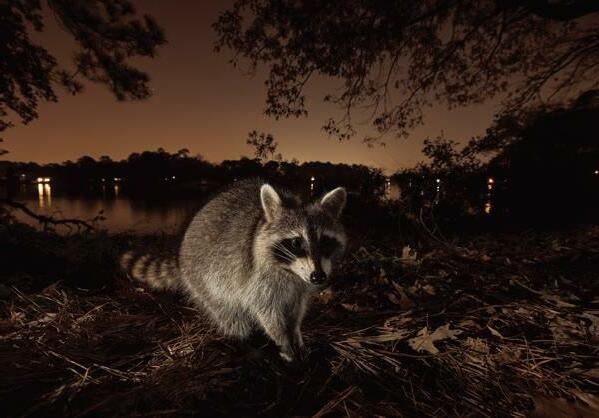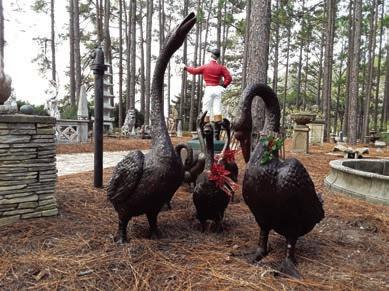
5 minute read
Naturalist By Todd Pusser
Spy in the Woods
With camera traps, every day is like Christmas
Advertisement
stoRy And photogRAphs By todd pusseR
Dappled sunlight, filtered by a
canopy of oak and pine, illuminates the trail that snakes along the edge of Eagle Branch Creek. The raucous calls of a red-shouldered hawk pierce the crisp fall air as I walk quietly toward a camera that I had mounted to the side of a tree next to the small creek. Every two months for the past three years, I have made the same woodland trek to check this camera, simply to satisfy my curiosity as to what animals are found in the woods so close to my childhood home in Eagle Springs.
Camera trap photograph of a gray fox.
Most wild animals, especially mammals, are extremely wary of humans. They see, hear or smell us long before we are aware of their presence. Many species are nocturnal and are only active when the cover of darkness masks their movements. As such, it can be nearly impossible to observe wild animals in their natural habitat. To remedy this, I use a weatherproof camera trap that can be left in the woods for long periods of time, and is capable of recording images day and night. A motion-activated sensor attached to the camera records photos or video of any animal that passes by.
The concept of camera trap photography has been around for over 100 years, when pioneering nature photographer George Shiras used a crude, but complex, remote system of trip wires and flashes fired by exploding magnesium powder, to record images of animals along the shores of Lake Superior in Michigan. The resulting photographs, published in National Geographic Magazine in 1913, became instant sensations. Since that time, the use of camera traps (also known as trail cameras, game cameras, remote cameras, etc.) has increased exponentially, with hundreds of models now commercially available in a wide range of budgets. I use inexpensive Browning trail cameras to record high-definition video as well as custom-built camera traps that house my Canon DSLR cameras for professional quality images.
Camera traps are used for a variety of applications and have become essential tools for many nature enthusiasts, from zoologists who want to monitor rare species in remote tropical jungles, to hunters hoping to bag a

Camera trap photograph of a raccoon.
Camera trap photograph from Eagle Springs of a fox squirrel.

trophy buck on local game lands, to naturalists wanting to learn what animals visit their backyards.
Finally arriving at the camera, I sit down next to the tree and remove a small laptop from my backpack. Pulling the memory card from the camera trap, I insert it inside the portable computer. Like a kid on Christmas morning, I wait with eager anticipation for what surprises the camera might hold.
Over the three years that the camera has remained at this spot, it has recorded a remarkable diversity of wildlife. Opossums, raccoons, grey squirrels, cottontail rabbits and whitetailed deer are seen nearly every day and night throughout the year. More surprising was a nearly-black, striped skunk seen nosing through the leaf litter one cold December night. In a lifetime of exploring the woods of Moore County, I have only observed the pungent mammals on two other occasions.
Another surprise was the large, heavily spotted bobcat that made a near daily appearance in front of the camera one April. Once, the camera recorded a video clip of a pair of river otters playfully sliding down the muddy creek bank and splashing into the water. More recently, for a period of several afternoons in July, when temperatures hovered well north of 90 degrees, a barred owl would land next to the creek, lay down on the ground and stretch its wings far out to the side, arch its head back and close its eyes, seemingly soaking in the sun.
By far, the rarest and most unusual animal recorded here over the last three years was a long-tailed weasel. From conversations I have had with local elderly farmers, weasels were apparently much more common 60 or 70 years ago, when their raids of chicken coops drew much consternation. They are rarely encountered now in the Sandhills. The short video clip of a weasel bounding right to left across the frame on a late summer evening provides tantalizing proof that the miniature carnivores still exist here. I have yet to see a live one with my own eyes.
Finally, the memory card finishes downloading. Leaning back against the tree, I thumb through the 80 videos that the camera has captured over the past two months. Once again, raccoons, opossums and deer make up most of the video captures. The highlight is a pair of gray foxes that wandered by the camera in the middle of the afternoon, with noses to the ground.
Copying the videos to my hard drive, I clear the memory card and reinsert it into the camera along with a fresh supply of batteries. It will be another two months before I check the camera again, but I am already counting the days until I can discover what new marvels it may hold. PS

Naturalist and photographer Todd Pusser grew up in Eagle Springs. He works to document the extraordinary diversity of life both near and far. His images can be found at www.ToddPusser.com.
Camera trap photograph of an opossum.


1650 Valley View Road• Southern Pines, NC
Adjacent to Hyland Golf Course on US 1 910-692-0855 • www.WindridgeGardens.com
Fall Hours: Wed.-Sat. 10AM-5PM • Sun. 1PM-5PM
Give a Gift That Touches the Soul
Visit our retail store for locally hand-crafted products
Or order online for drop ship delivery Place orders before December 14th for Christmas delivery
FROM BARREL TO BANNER
Mon- Fri 9 to 3 or by appointment 230 S. Bennett St., Southern Pines (910) 725-1540 Shop online 24/7 – www.theheritageflag.com










